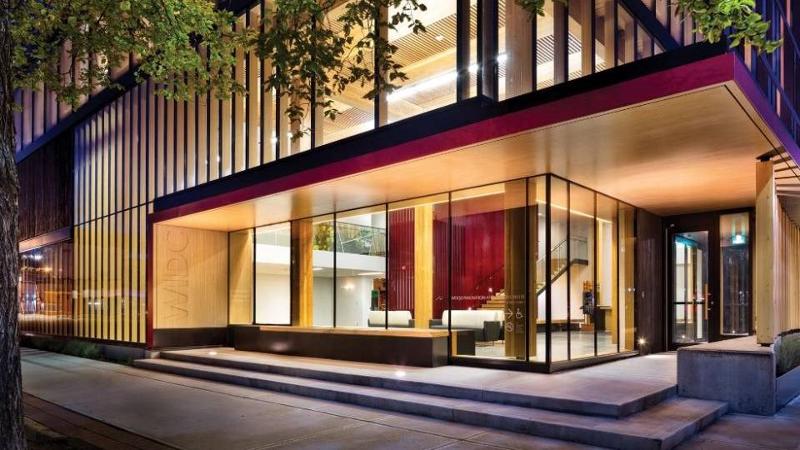Join us as we delve into the mind of Michael Green, principal architect at MGA, and uncover his groundbreaking vision for the future of sustainable construction materials. Discover how the use of bio-based materials, inspired by nature, could revolutionize the industry and pave the way for a greener and more efficient approach to building design.
The Toward Sustainable Construction
A glimpse into the current construction practices and the need for a sustainable alternative.
In the world of design and construction, the quest for sustainability has become almost mythical. However, Michael Green, the renowned architect and founder of Michael Green Architecture (MGA), believes the true sustainability lies in moving away from carbon-intensive materials such as concrete, steel, and masonry. Discover why the prevalent construction trends are not the solution and explore Green's radical approach to embracing new plant-based materials that align with the principles of nature.
By challenging the dominance of traditional construction industry giants, Green aims to redefine our understanding of sustainable architecture. He emphasizes the urgent need to replace outdated materials with innovative biobased solutions, such as grass, hemp, bamboo, mycelium, and kelp. Join us as we dive into the possibilities these novel materials present, and how they could dramatically change the future of construction.
Revolutionizing the Way We Build
Unveiling Michael Green's distinct vision for sustainable construction methodologies inspired by nature.
In his journey as an architect, Michael Green has emerged as a leader in wood-based constructions. Unlike traditional practices that heavily rely on concrete and steel, Green's approach primarily employs wood, with concrete and steel only used in secondary structures and foundations. Through remarkable projects like the Wood Innovation and Design Centre and T3 Minneapolis, Green has demonstrated the immense potential of mass timber construction.
However, Green doesn't settle for mere wood constructions. His newest pioneering venture, 'Planthouse,' explores the idea of using various biobased materials like bamboo, grass, and more. Green's vision combines plant-based fibers, computational modeling, and advanced robotic technologies to redefine the building process and mimic the efficiency and sustainability found in nature itself. Embark with us on this fascinating exploration of how Green aims to revolutionize the way we build and the potential impact on the industry at large.
Unlocking the Potential of Plant-Based Fibers
Understanding the unique strength and versatility of plant materials in sustainable construction.
In nature, plant structures utilize cellulose fibers and lignified tissues to create innovative structures capable of providing immense strength while being lightweight and sustainable. However, in conventional construction, we often ignore the possibilities offered by nature's design, opting for wasteful rectilinear forms. Consequently, inefficiency and excessive waste dominate architectural practices.
Michael Green challenges this mindset by advocating for the use of plant-based fibers like flax, hemp, and sweetgrass. By harnessing the unique properties of these materials, builders can create a cross-laminated timber, a groundbreaking substitution for traditional carbon-intensive building materials. Join us in exploring the extraordinary potential inheren.
Shifting Perspectives: Embracing Sustainable Innovation
Encouraging architects and designers to become agents of change and advocates for sustainable construction.
The transition towards sustainable construction demands a collective effort from architects and designers. Michael Green urges the design community to take ownership of their voice and agency, fostering a culture of innovation and pushing for sustainable change. At a time when construction needs peak, it becomes increasingly vital to motivate industry professionals to embrace nature-inspired building practices.
As Green propels the conversation around sustainable architecture, there is a pressing demand for awareness and investment from the global community. By engaging in meaningful dialogue, sharing ideas, and showcasing the immense potential of innovative biobased solutions, architects can become leaders in driving transformative change. Let us inspire one another to redefine the future of construction with the vision outlined by Michael Green.
Conclusion
Michael Green's innovative approach to sustainable construction materials offers a glimpse into the future of architecture. By moving away from carbon-intensive materials and embracing bio-based alternatives inspired by nature, Green challenges the industry status quo and paves the way for more environmentally friendly building practices.
Through the use of plant-based fibers and advanced technologies, such as computational modeling and robotic forming, architects can create structures that minimize waste and resource consumption while maximizing strength and efficiency. It is crucial for the design community to take a leadership role in advocating for these sustainable solutions and driving transformative change within the industry.
As the demand for construction grows, it is essential for builders, architects, and designers to explore and adopt biobased materials. By aligning our practices with the wisdom of nature, we can shape a future where buildings harmonize with the environment and contribute to a more sustainable and resilient planet.
FQA :
What are the benefits of using biobased construction materials?
Using biobased construction materials offers numerous benefits such as reduced carbon emissions, improved resource efficiency, and increased strength-to-weight ratio. These materials also promote circularity by utilizing natural fibers that can be renewable and biodegradable.
Why is it important for architects to embrace innovative sustainable solutions like plant-based materials?
Architects play a crucial role in shaping the built environment. By embracing innovative sustainable solutions like plant-based materials, architects can lead the way towards a more sustainable future. They have the power to influence and transform the construction industry, reducing its carbon footprint and creating healthier, more resilient buildings.
How can the use of bio-inspired materials contribute to a greener building industry?
Bio-inspired materials offer the potential to revolutionize the building industry by using design principles derived from nature. These materials can minimize waste, improve energy efficiency, and enhance the overall sustainability of construction projects. By aligning with nature's ingenuity, the building industry can make significant strides in achieving a greener and more environmentally conscious future.

